When you pick up a prescription, most people think the pharmacist just counts pills and hands over a bottle. But if you’re on multiple medications - especially chronic ones like blood pressure pills, diabetes drugs, or antidepressants - your pharmacist might be doing something far more important: running a medication therapy management (MTM) session. And right in the middle of that? They’re looking at your generic drugs.
Generic drugs aren’t cheaper knockoffs. They’re exact copies of brand-name medicines, approved by the FDA to work the same way, with the same active ingredients, in the same doses. But here’s the catch: many patients don’t believe that. They think generics are weaker. Or they’ve had a bad experience with one. And that’s where pharmacists step in - not just to fill prescriptions, but to fix misunderstandings, cut costs, and keep people alive.
What Medication Therapy Management Really Means
Medication Therapy Management isn’t a buzzword. It’s a formal, structured service. The American Pharmacists Association defines it as a patient-centered process where pharmacists review every medication a person takes - prescription, over-the-counter, even supplements - to make sure each one is necessary, safe, and working as it should.
This isn’t a quick chat at the counter. A full MTM session lasts 20 to 40 minutes. The pharmacist asks: Are you taking this correctly? Are you having side effects? Are you skipping doses because it’s too expensive? Are you taking five different pills for the same condition? Are any of these interacting dangerously?
And here’s where generics come in. The average patient on Medicare Part D takes seven medications. If even two of those are brand-name drugs with generic equivalents, that’s $200-$400 a month in savings just by switching. Pharmacists are trained to spot those opportunities - and they’re the only healthcare providers who can do it at scale, across all your meds, all at once.
Why Pharmacists Are the Only Ones Who Can Do This Right
Doctors write prescriptions. Nurses manage care. But only pharmacists know the full landscape of every drug on the market - including which generics are truly equivalent, which ones aren’t, and why.
The FDA rates generics in the Orange Book. An "A" rating means it’s therapeutically equivalent to the brand. A "B" rating? That’s a red flag. Maybe the generic has a different inactive ingredient that affects absorption - especially dangerous with drugs like warfarin, levothyroxine, or seizure medications. Pharmacists check this every time. They don’t just assume all generics are the same.
And they don’t just swap drugs blindly. They talk to patients. One study found that 26% of people skip doses because of cost. That’s not laziness - it’s survival. A patient on a $400/month brand-name inhaler might be choosing between medicine and groceries. When a pharmacist switches her to a $15 generic with the same active ingredient, it’s not just a cost cut. It’s a life saved.
MTM pharmacists don’t just recommend substitutions - they explain them. They show patients the FDA data. They compare pill sizes, side effect profiles, and even packaging. They answer the real question: "Will this still work?" And when patients hear it from someone who’s spent 10 years studying drug interactions, they listen.
The Real Impact: Numbers That Matter
MTM isn’t feel-good fluff. It’s backed by hard data.
- Patients who get MTM services improve their medication adherence by nearly 19 percentage points - that’s the difference between taking pills every day and missing half your doses.
- Medication errors drop by 61% when pharmacists lead the review.
- Hospital readmissions fall by 23% within 30 days after an MTM session.
- Patients save an average of $214 a month just by switching to appropriate generics.
One HealthPartners study showed that when pharmacists actively optimized generic use during MTM, patients saved 32% on their total drug costs. That’s not a small discount. That’s enough to cover rent, groceries, or transportation to appointments.
And it’s not just Medicare. Employers who offer MTM through workplace health plans see $3.17 saved for every $1 spent. That’s why big companies like Walmart, CVS, and UnitedHealthcare now require their pharmacists to offer MTM - not as a perk, but as a core part of care.
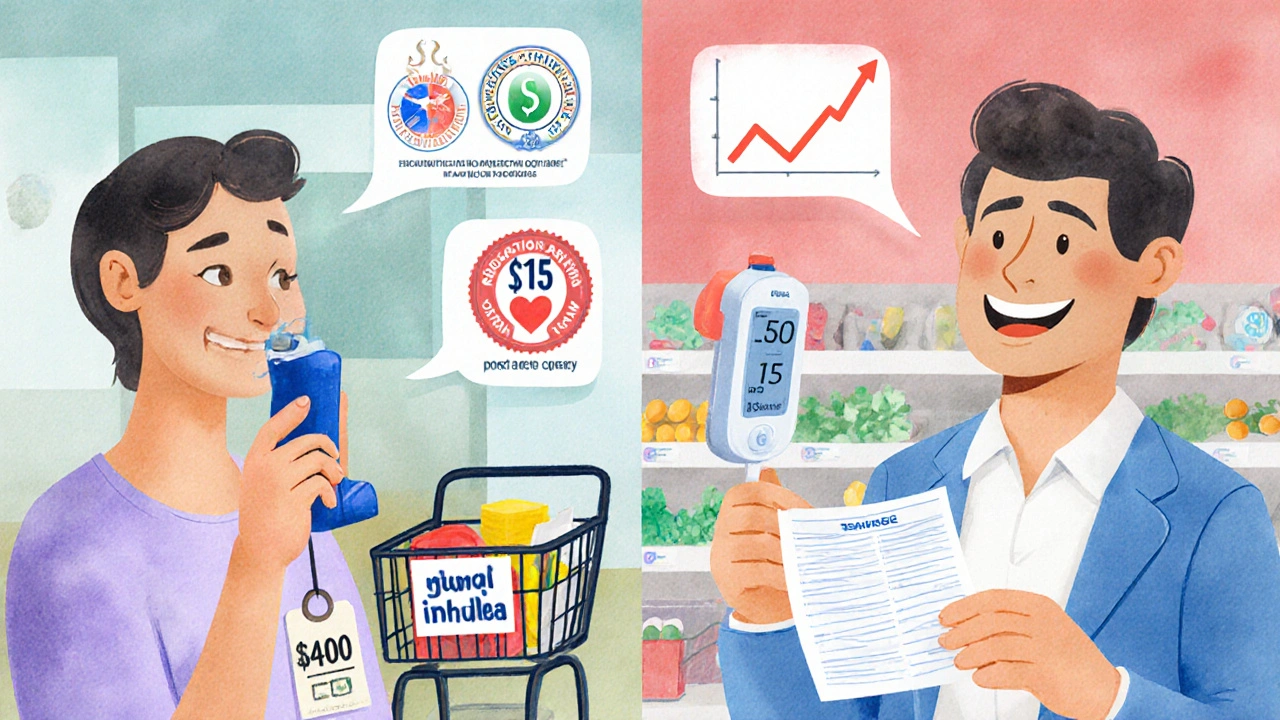
How Pharmacists Handle Generic Substitutions - Step by Step
It’s not as simple as swapping a brand for a generic. Here’s how it actually works:
- Review the full list - All meds, including OTC and supplements. Many patients don’t tell their doctor they’re taking ibuprofen daily or fish oil - but pharmacists catch it.
- Check the Orange Book - Is the generic rated "A"? Is it a narrow therapeutic index drug? If yes, extra caution is needed.
- Assess patient history - Did they have a bad reaction to a generic before? Was it the drug or the filler? Did they switch and feel worse? That’s not always the drug’s fault - sometimes it’s the brand’s placebo effect.
- Calculate cost impact - How much will this save? Can they go from $300/month to $40? That’s life-changing.
- Communicate clearly - "This generic has the same active ingredient as your brand. It’s been tested on thousands of people. It works the same. And it’s 90% cheaper. Would you like to try it?"
- Document and follow up - Did the switch work? Any new side effects? Did they refill? That’s tracked in a Medication-Related Action Plan.
Pharmacists use tools like the Medication Appropriateness Index (MAI) to score each drug on 10 criteria: Is it needed? Is the dose right? Is it affordable? Is it safe with other meds? This isn’t guesswork. It’s a clinical checklist.
The Barriers - Why More People Don’t Get MTM
Despite the evidence, only 15-25% of eligible Medicare patients actually get an MTM session. Why?
First, most people don’t know it exists. They think it’s just a refill. Pharmacies don’t always advertise it. And Medicare doesn’t push it hard enough.
Second, reimbursement is a mess. Medicare pays $50-$150 per session. Commercial insurers? $25-$75. Some pharmacies can’t afford to spend 30 minutes on a patient if they’re only getting paid $30. That’s why rural and independent pharmacies often skip MTM - even though they’re the ones who need it most.
Third, electronic health records don’t talk to pharmacy systems. If your doctor doesn’t see what the pharmacist changed, they might re-prescribe the brand-name drug. That’s a system failure - not a pharmacist’s fault.
And then there’s the stigma. Some patients still believe generics are "inferior." One Reddit user shared a story about a woman crying because her $400 inhaler was switched. The pharmacist spent 20 minutes showing her the FDA data, the clinical studies, and even the pill dissolution charts. She started crying again - but this time, from relief. She could breathe. And afford it.
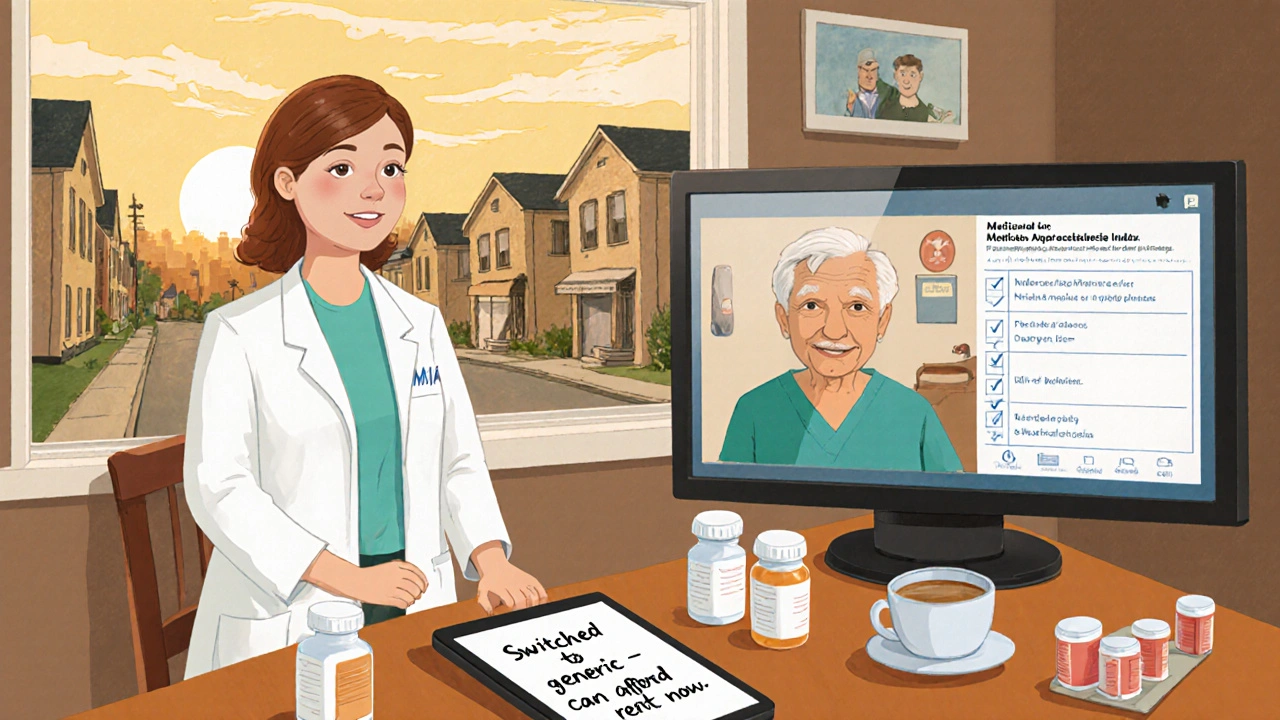
What’s Changing - And What’s Next
MTM is growing. In 2022, over 12 million Medicare beneficiaries received MTM services. That’s up from just 2 million in 2007. Telehealth MTM is now common - 63% of programs offer virtual sessions. You can get your review from your kitchen table.
Some pharmacists are now using pharmacogenomics - testing how your genes break down drugs - to decide whether a generic is truly the best fit. That’s next-level precision.
The Pharmacist Medicare Benefits Act, passed in the House in 2021, could expand MTM access to 38 million more Americans if it becomes law. That’s huge. But until then, the best way to get MTM is to ask.
If you’re on more than three medications, especially if you’re paying out of pocket, walk into your pharmacy and say: "Do you offer Medication Therapy Management?" If they say no, ask why. If they say yes, schedule the appointment. Don’t wait for them to call you. They probably won’t.
What Patients Should Know
You don’t need a referral. You don’t need to be sick. You just need to be taking meds - and you want to make sure you’re not overpaying, underdosing, or risking side effects.
Here’s what to expect:
- A full list of all your meds - bring your pill bottles or a list.
- A 30-minute conversation - no rush, no judgment.
- A written plan - what to keep, what to change, what to watch for.
- A follow-up - usually in 3-6 months.
And if your pharmacist suggests a generic? Don’t say no because it’s cheaper. Say yes because it’s the same medicine - and now you can afford to take it every day.
Are generic drugs really as good as brand-name drugs?
Yes. The FDA requires generic drugs to have the same active ingredient, strength, dosage form, and route of administration as the brand-name version. They must also meet the same strict standards for purity, stability, and bioequivalence. Studies show generics work just as well in real-world use. The only differences are in inactive ingredients (like fillers), which rarely affect effectiveness.
Can pharmacists switch my brand-name drug to a generic without my doctor’s permission?
In most cases, yes - but only if the prescription allows substitution and the generic is rated "A" by the FDA. Pharmacists can legally substitute unless the doctor writes "dispense as written" or "no substitution." Even then, they can still recommend a switch and contact your doctor to suggest it. Many doctors welcome the input - especially when it saves patients money.
Why do some people feel worse after switching to a generic?
Sometimes it’s psychological - people expect the generic to be weaker. But in rare cases, differences in inactive ingredients can affect how the drug is absorbed, especially with narrow therapeutic index drugs like levothyroxine or warfarin. That’s why pharmacists check the Orange Book and monitor patients closely after a switch. If symptoms appear, they’ll re-evaluate and may suggest switching back or trying a different generic.
Is MTM covered by insurance?
Yes - if you’re on Medicare Part D and take multiple chronic medications, you’re eligible for free MTM services. Many private insurers also cover it, especially if you’re on five or more prescriptions. Check your plan’s website or call member services. If your pharmacy doesn’t offer it, ask why - it might be a reimbursement issue, not a policy one.
How do I know if I’m a good candidate for MTM?
You’re likely a good candidate if you take three or more prescription medications for chronic conditions (like diabetes, high blood pressure, or heart disease), have been hospitalized recently, or pay over $100 a month out of pocket for drugs. Even if you don’t think you need it, MTM can uncover hidden problems - like duplicate prescriptions, dangerous interactions, or unnecessary drugs.
If you’re taking meds - especially generics - don’t assume they’re working perfectly. Talk to your pharmacist. Ask for MTM. It’s free, it’s safe, and it could save you hundreds a month - and maybe your life.

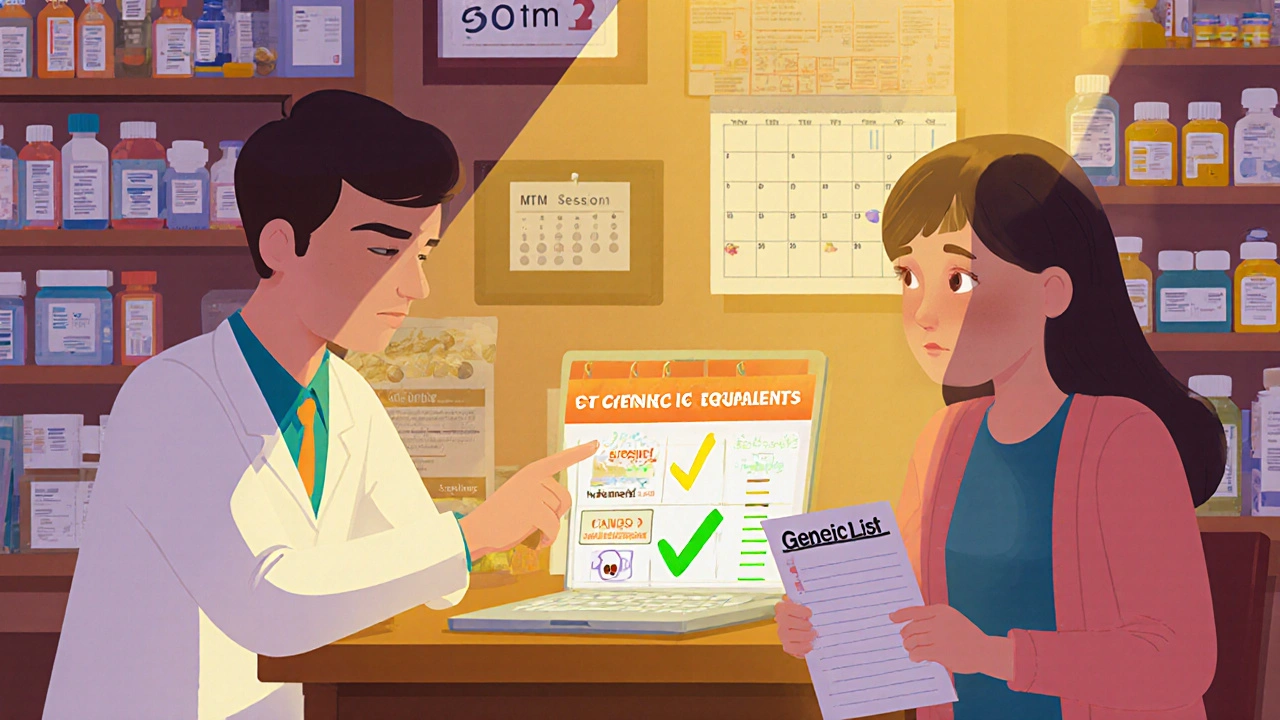
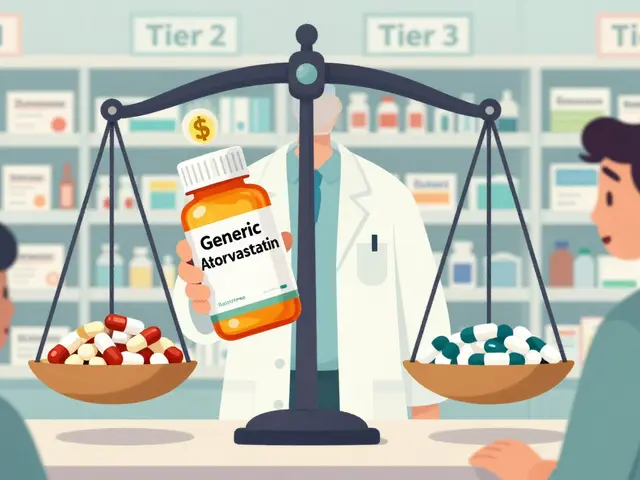
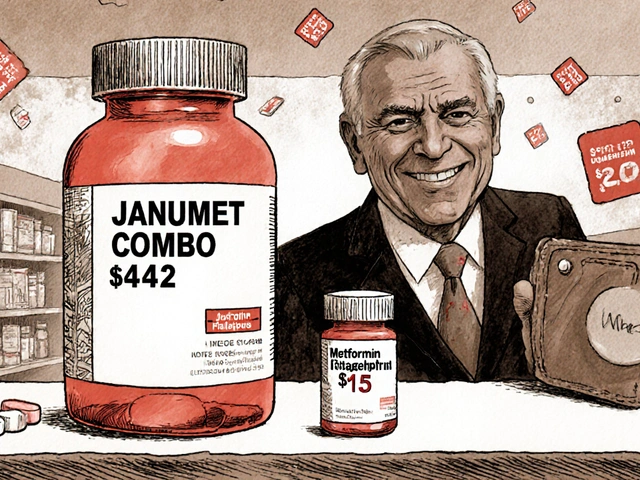

Comments
just wanted to say i switched my levothyroxine to generic last year after my pharmacist walked me through the bioequivalence data. no difference in my tsh levels, and i saved $280/month. also, she caught i was doubling up on ibuprofen and my blood pressure was spiking. lifesaver.
okay but have you ever heard of the big pharma shadow network? they don't want you to know that generics are secretly made in the same factories as brand names, then repackaged with a different label. the FDA? totally bought and paid for. my cousin’s aunt’s neighbor took a generic blood pressure med and ended up in the ER because the fillers were laced with industrial-grade talc. they covered it up. i’ve seen the documents. it’s not about cost-it’s about control. you think your pharmacist is helping? they’re just the front line for the cartel. and don’t get me started on the orange book-it’s a lie. they rate generics based on what the company pays them to say. i’m not paranoid. i’m informed.
ask for mtm. it’s free. it helps.
the pharmacoeconomic implications of therapeutic substitution under medicare part d are non-trivial. the adherence metrics cited in the post align with the 2021 JAMA study on medication therapy management efficacy, particularly in patients with polypharmacy and narrow therapeutic index agents. the orange book’s therapeutic equivalence designations remain the gold standard, though post-marketing surveillance reveals variable bioavailability in certain generic formulations-particularly for drugs like warfarin and levothyroxine. pharmacists are uniquely positioned to perform therapeutic drug monitoring and adjust substitutions based on pharmacokinetic parameters, which primary care providers rarely have the bandwidth to track. institutional barriers-such as ehr interoperability gaps and inadequate reimbursement-remain systemic obstacles to scalability.
It is regrettably common for laypersons to conflate cost-efficiency with therapeutic inferiority. The FDA’s bioequivalence requirements mandate that generic formulations demonstrate no more than a 20% variance in pharmacokinetic parameters compared to the reference listed drug. This is not a suggestion-it is a regulatory mandate enforced through rigorous in-vivo and in-vitro testing. To suggest otherwise is not only scientifically inaccurate, but also dangerously misleading to vulnerable populations. The notion that pharmacists are merely ‘sales agents’ for cost-cutting is a gross mischaracterization of their clinical role.
Yeah right. So the pharmacist is the hero now? What about the 30-minute session where they just read from a script while you’re standing there holding your 17 prescriptions? And then they switch your meds without telling your doctor. I got a new generic for my antidepressant and suddenly I felt like a zombie for two weeks. My doctor didn’t even know it changed. Who’s accountable here? The pharmacist? The pharmacy chain? The insurance company? Nobody. It’s a mess. And now you’re telling me to just ‘ask for mtm’ like it’s a free cup of coffee? No thanks. I’ll keep paying $400 for the brand name that doesn’t turn me into a ghost.
the data is statistically significant but culturally irrelevant. in india, generics are the only option, and yet adherence rates are below 35% due to systemic mistrust, not cost. this post assumes access, education, and infrastructure exist. they don’t. the real problem isn’t the pharmacist-it’s the healthcare system that lets people die because they can’t afford to walk into a pharmacy. also, the orange book is outdated. many generics use different salts, and the bioequivalence window is too wide for psychiatric drugs. this is american privilege wrapped in clinical jargon.
so let me get this straight: the person who spent 10 years memorizing drug interactions, knows every filler in every pill, and can tell you why your generic thyroid med is suddenly making you jittery… is just a ‘pill counter’? 🤡
Meanwhile, doctors are busy juggling 20 patients an hour and still think ‘just take your meds’ is a valid treatment plan.
Pharmacists are the unsung heroes of modern medicine-except when they’re being paid $30 to do a 40-minute consult that could literally prevent a hospitalization.
Also, if your pharmacist suggests a generic and you cry? Maybe you’re not crying because it’s ‘inferior’-maybe you’re crying because you finally realized you’ve been paying $300/month for a pill that costs $15 to make. 💸😭
It is an absolute moral failing that the pharmaceutical industry, in collusion with regulatory agencies, has normalized the substitution of life-sustaining medications with inferior, untested, and potentially toxic alternatives. I have personally witnessed the degradation of patient outcomes since the widespread adoption of generic substitution protocols. The FDA’s Orange Book is a farce-its criteria are antiquated, its testing protocols are insufficient, and its oversight is laughably lax. To suggest that a patient should ‘trust’ a pharmacist to make such a decision is not only irresponsible-it is negligent. Furthermore, the normalization of cost-driven therapeutic decisions represents a chilling erosion of medical ethics. Patients are not commodities. Their health is not a line item. And yet, here we are, applauding pharmacists for reducing costs while silently allowing lives to be compromised in the name of profit.
Interesting how the article conveniently omits the fact that the majority of generic drugs are manufactured in China and India, where regulatory oversight is minimal. The FDA inspects less than 2% of foreign facilities. How can you be sure the generic you’re taking isn’t contaminated with carcinogens or heavy metals? The ‘same active ingredient’ argument is a distraction. What about the excipients? The binders? The dyes? These are not inert. They can trigger autoimmune responses, especially in sensitive individuals. This isn’t medicine-it’s a gamble. And the pharmacist? They’re just the guy handing you the loaded dice.
my grandma got mtm last year and now she’s taking 3 pills instead of 11. saved her $300/month and her knees don’t hurt as bad because they cut her ibuprofen. pharmacist even called her doctor to switch her blood pressure med to a generic that didn’t make her cough. 🙌
if you’re on more than 3 meds, just ask. no shame. they’re there to help. not sell you stuff. 💊❤️
Let’s be real-this whole MTM thing is just a corporate ploy to offload responsibility onto pharmacists while insurance companies pocket the savings. The ‘23% reduction in hospital readmissions’? That’s a 30-day window. What about the 6-month follow-up? No one tracks that. And the $214 monthly savings? Sure, if you’re on Medicare and live in a city with a chain pharmacy. Try getting MTM in rural West Virginia where the pharmacist is also the owner, the cashier, and the janitor. They don’t have time to sit with you for 40 minutes while you cry about your inhaler. And don’t even get me started on the fact that 80% of these ‘successful’ MTM cases are only counted because the patient refilled their prescription. That’s not adherence-that’s just fear of running out. This isn’t healthcare innovation. It’s cost-shifting dressed up as compassion.